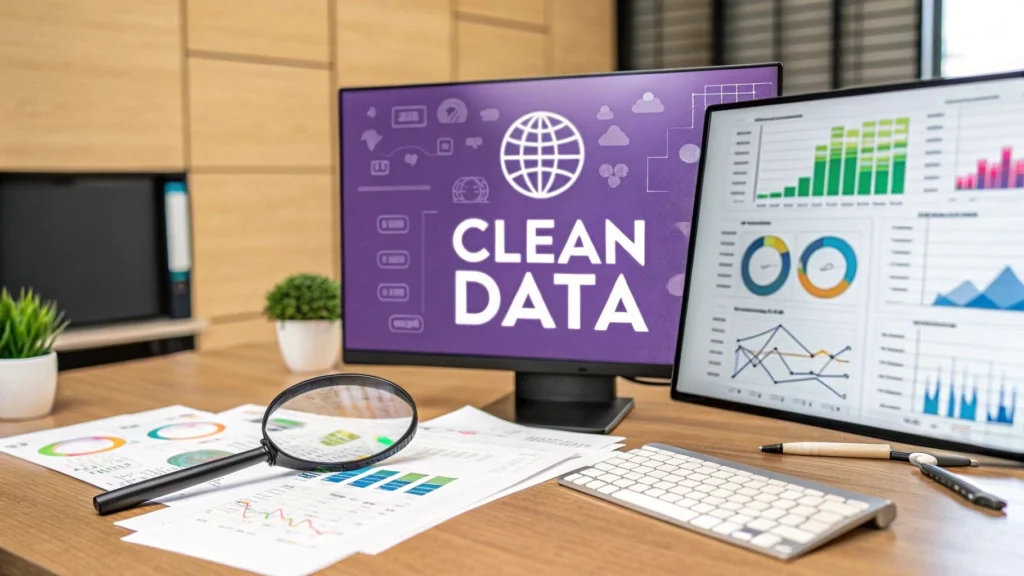7 Essential Data Cleansing Methods for 2025
Discover 7 essential data cleansing methods to improve data quality and drive better business decisions. A complete guide for accurate, reliable data in 2025.

In the age of big data, the quality of your insights is directly tied to the quality of your data. Raw data, however, is often messy, inconsistent, and riddled with errors. This is where data cleansing, the process of detecting and correcting corrupt or inaccurate records from a dataset, becomes crucial. Effective data cleansing is not just a technical task; it’s a strategic imperative that underpins reliable analytics, trustworthy machine learning models, and confident decision-making across an organisation. Ignoring this foundational step can lead to flawed strategies, wasted resources, and significant missed opportunities. Truly clean data empowers more accurate and insightful Business Intelligence initiatives, helping organizations of all sizes make better, data-driven decisions.
This article dives deep into the seven most impactful data cleansing methods that modern enterprises must master to maintain a competitive edge. We will move beyond theory to explore each technique in detail, providing practical implementation guidance, specific real-world scenarios, and a clear-eyed analysis of their respective pros and cons. Our goal is to equip you with the actionable knowledge needed to transform your raw, unreliable data into a valuable and trustworthy asset that fuels scalable growth.
1. Data Profiling and Statistical Analysis
Before you can fix dirty data, you must first understand its nature. Data profiling is the foundational first step in any robust data cleansing strategy, acting as a diagnostic tool to uncover the full scope of quality issues. This method involves a comprehensive examination of your datasets to understand their structure, content, quality, and metadata. By applying statistical measures and visualisation techniques, you can systematically identify the problems that need fixing.

Think of it as performing a health check on your data. Profiling reveals critical insights such as value distributions, frequency counts, data types, and key relationships between different data tables. This initial analysis is crucial because it informs which specific data cleansing methods will be most effective, saving significant time and resources down the line.
How it’s Implemented
The process typically begins with automated tools like Talend or Informatica to perform an initial scan. These platforms can quickly analyse large volumes of data to generate reports on completeness (e.g., percentage of null values in a column), uniqueness (e.g., identifying duplicate customer IDs), and validity (e.g., flagging postcodes that don’t match a standard format).
For instance, a major retailer like Walmart uses data profiling on its vast inventory data. By analysing stock levels, supplier information, and sales dates, it can spot inconsistencies like products with negative stock counts or mismatches in seasonal demand patterns. This allows them to correct the data before it impacts supply chain decisions.
Key Implementation Tips
To maximise the effectiveness of this method, consider the following:
- Prioritise Business-Critical Fields: Don’t try to profile everything at once. Start with data fields that directly impact key business operations, such as customer contact details or financial transaction records.
- Use Sampling for Large Datasets: For massive databases, analysing a statistically significant sample can provide initial insights quickly without overwhelming your systems.
- Document Everything: Maintain a detailed log of all findings, including timestamps and the specific issues uncovered. This creates an essential audit trail and helps track cleansing progress over time.
- Combine Statistical Measures: Relying on a single metric can be misleading. A comprehensive assessment requires combining measures like mean, median, mode, standard deviation, and frequency distributions for a complete picture of data quality.
2. Deduplication and Record Matching
Duplicate data is a pervasive issue that can severely undermine the integrity of business intelligence, marketing campaigns, and operational efficiency. Deduplication, also known as record matching or entity resolution, is one of the most critical data cleansing methods for resolving this problem. It involves systematically identifying, merging, or removing records that refer to the same real-world entity, even if the entries are not identical.

This method goes beyond finding exact matches. It employs sophisticated algorithms to detect similarities across multiple attributes, handling variations in spelling, formatting, and completeness. A clean, deduplicated database ensures that each customer, product, or transaction is represented only once, providing a single source of truth that is essential for accurate analysis and trustworthy decision-making.
How it’s Implemented
Implementation relies on algorithms that compare records and calculate a similarity score. These can range from simple deterministic rules (e.g., matching on an exact email address) to complex probabilistic or machine learning models that weigh different fields based on their reliability. Popular libraries like Python’s RecordLinkage or tools like Dedupe.io are often used to manage this process.
For example, Salesforce’s Einstein Duplicate Management uses this technique to identify potential duplicate customer leads or contacts. It flags records like “John Smith” at “ABC Corp” and “J. Smith” at “ABC Corporation,” allowing sales teams to merge them. This prevents multiple salespeople from contacting the same lead and ensures a unified view of customer interactions. Effective deduplication can be a powerful complement to strategies designed to automate data entry and streamline workflows.
Key Implementation Tips
To execute deduplication effectively, consider these best practices:
- Use Blocking Strategies: To avoid comparing every record to every other record (which is computationally expensive), group similar records into “blocks” based on a common attribute like a postcode or company name first.
- Implement a Human Review Queue: Not all matches will be clear-cut. Set up a workflow for borderline cases to be reviewed by a data steward to prevent incorrect merges.
- Start with High-Confidence Matches: Begin by merging only the records that meet a very high similarity threshold. You can gradually lower the threshold as you refine your matching rules and gain confidence in the process.
- Maintain an Audit Trail: Keep a log of all merge decisions, including which records were merged, when, and by what rule. This is crucial for accountability and for reversing any errors.
3. Data Validation and Business Rules Engine
Where data profiling identifies problems, data validation and business rules engines actively prevent them. This systematic approach ensures that incoming and existing data adheres to predefined business rules, quality standards, and operational constraints. It involves creating and applying a set of logical conditions that data must pass, automatically flagging or rejecting entries that fail to meet the criteria.

Think of it as setting up a highly diligent gatekeeper for your database. This gatekeeper checks every piece of data against a comprehensive rulebook before allowing it entry, ensuring only compliant, high-quality information populates your systems. This method moves data cleansing from a reactive, after-the-fact process to a proactive, preventative measure, safeguarding data integrity at the source.
How it’s Implemented
Implementation relies on platforms like Drools, Oracle Business Rules, or the open-source library Great Expectations. These tools allow you to define rules programmatically or through a user interface. For instance, a financial institution might implement a rule that all transaction amounts must be positive numbers and that no transaction can exceed an account’s predefined credit limit. If a transaction violates these rules, it’s flagged for review instead of being processed.
Similarly, in healthcare, a rule engine ensures all patient records comply with HIPAA standards, such as verifying that a patient’s age is within a logical range (e.g., 0-120). Advanced techniques are also emerging, such as using Identity Validation with Machine Learning to verify customer identities against complex patterns, adding another layer of sophisticated validation. You can learn more about different data validation techniques on Osher.com.au.
Key Implementation Tips
To effectively deploy a rules engine as one of your core data cleansing methods, follow these tips:
- Start with Critical Rules: Begin by defining rules for your most business-critical data elements, such as financial data or customer identifiers, and expand your rule set over time.
- Implement Severity Levels: Categorise rule violations (e.g., critical error, warning, informational) to prioritise remediation efforts and distinguish between data that must be blocked versus data that simply needs a flag.
- Provide Clear Error Messages: When a validation fails, the system should generate a descriptive error message explaining which rule was broken and why. This is crucial for guiding manual correction.
- Use Version Control for Rules: Business logic changes. Keep your rules in a version control system (like Git) to track modifications, roll back to previous versions, and manage the rule lifecycle effectively.
4. Data Standardization and Normalization
Inconsistent data formats are a silent killer of data integrity. Data standardisation and normalisation is a critical data cleansing method that transforms disparate data into a consistent, uniform format. This process applies a common set of rules and conventions to ensure that similar data elements are represented identically across all systems, which is vital for effective data integration, analysis, and reporting.

Think of it as creating a universal language for your data. Without standardisation, one system might store a state as “NSW” while another uses “New South Wales.” These variations, though minor, can cause significant errors in analytics and operational workflows. By enforcing a single, standard format, you eliminate ambiguity and enable your systems to communicate and function cohesively.
How it’s Implemented
Implementation often involves using rule-based transformations, lookup tables, and regular expressions to convert data into a predefined format. Tools like Apache NiFi or custom scripts can be configured to automatically apply these rules during data ingestion or processing. The goal is to enforce consistency systematically rather than through manual, error-prone corrections.
For example, a national logistics company uses Australia Post’s address validation services to standardise all customer shipping addresses. This process automatically corrects street names, formats postcodes correctly (e.g., 2000 instead of 2,000), and ensures every address conforms to the official postal standard. This not only improves delivery success rates but also allows for accurate geospatial analysis for route optimisation.
Key Implementation Tips
To effectively standardise your datasets, consider these practical steps:
- Use Industry-Standard Formats: Wherever possible, adopt established standards like ISO 3166 for country codes or ISO 4217 for currency codes to ensure interoperability.
- Maintain Mapping Tables: Create and manage reference tables that map common variations (e.g., “AU,” “Aus,” “Australia”) to a single standard value. Keep these tables updated.
- Preserve Original Data: Store a copy of the original data alongside the standardised version. This provides an audit trail and allows you to revert changes or re-process data if standardisation rules evolve.
- Implement Post-Standardisation Validation: After applying rules, run validation checks to confirm that all data now conforms to the target format and that no information was lost or corrupted during the transformation.
5. Missing Data Imputation
In an ideal world, every dataset would be complete. In reality, missing values are a common and persistent problem that can skew analysis and undermine the reliability of machine learning models. Missing data imputation is a sophisticated data cleansing method that involves using statistical or machine learning techniques to estimate and fill in these gaps, thereby restoring the dataset’s integrity. This process goes beyond simple deletion, instead leveraging existing data to make informed predictions about what the missing values should be.
This method is critical because simply ignoring or deleting records with missing data can lead to biased results and a significant loss of valuable information. By intelligently imputing values, organisations can create more robust datasets for analysis, ensuring that business decisions and predictive models are built on a more complete and accurate foundation. It’s a proactive approach to preserving the statistical power of your data.
How it’s Implemented
Implementation can range from simple statistical approaches to complex model-based techniques. Basic methods include replacing missing values with the mean, median, or mode of a column. More advanced methods, popularised by statisticians like Donald Rubin, use algorithms to predict missing values based on relationships observed in the data. Tools like Python’s scikit-learn library or the MICE (Multivariate Imputation by Chained Equations) package in R are commonly used.
For example, Netflix uses a form of imputation called collaborative filtering. When you haven’t rated a movie, its system predicts what you would rate it based on the ratings of other users with similar tastes. Similarly, in medical research, if a patient’s lab result is missing, multiple imputation techniques are used to generate several plausible values, accounting for the uncertainty and preventing a single, potentially incorrect guess from skewing study outcomes.
Key Implementation Tips
To apply this data cleansing method effectively, follow these best practices:
- Analyse the Missingness Pattern: Before imputing, determine if data is missing completely at random (MCAR), at random (MAR), or not at random (MNAR). This diagnosis dictates the most appropriate imputation strategy.
- Use Multiple Imputation for Critical Analysis: For important statistical inferences, avoid single imputation (like mean-filling). Multiple imputation creates several complete datasets, runs the analysis on each, and pools the results to provide more accurate and reliable conclusions.
- Validate Imputation Results: Use techniques like cross-validation to assess how well your imputation model predicts known values that were artificially removed. This helps validate the accuracy of your chosen method.
- Document Assumptions: Clearly record the imputation method used and any assumptions made about the data. This transparency is vital for reproducibility and for understanding the potential impact on any downstream analysis.
6. Outlier Detection and Treatment
Outliers are data points that significantly deviate from the rest of the data, and their presence can distort statistical analyses and corrupt machine learning models. Outlier detection and treatment is a critical data cleansing method focused on identifying these anomalies and deciding how to handle them. This process uses statistical techniques, machine learning algorithms, and domain knowledge to pinpoint values that fall outside the expected range and then apply an appropriate correction strategy.
Effectively managing outliers is essential for maintaining data integrity and generating reliable insights. Ignoring them can lead to flawed conclusions, such as skewed financial forecasts or inaccurate patient health assessments. By systematically identifying and treating these unusual data points, organisations can ensure their analytical models are built on a foundation of accurate and representative data.
How it’s Implemented
Implementation often involves statistical methods popularised by figures like John Tukey, such as using the interquartile range (IQR) to define normal boundaries. More advanced approaches leverage machine learning libraries like Scikit-learn or specialised tools like PyOD, which offer algorithms such as Isolation Forest or Local Outlier Factor to detect anomalies in multidimensional datasets. The choice of method depends on the data’s complexity and dimensionality.
For example, a credit card company employs outlier detection to spot fraudulent transactions. A transaction that is unusually large, occurs in a foreign country, or is part of a rapid series of purchases would be flagged as an outlier by their system. This allows the company to immediately investigate and prevent further fraudulent activity, protecting both the customer and its own finances. Similarly, manufacturing systems use this to identify defective products based on sensor readings that fall outside normal operational parameters.
Key Implementation Tips
To ensure your outlier management is robust and doesn’t discard valuable information, follow these guidelines:
- Investigate Before Removing: An outlier isn’t always an error. It could be a legitimate but rare event, like a record-breaking sales day. Always investigate the root cause before deleting a data point.
- Use Multiple Detection Methods: Relying on a single algorithm can lead to false positives or negatives. Validate your findings by applying at least two different detection techniques to see if they identify the same outliers.
- Consider the Business Context: The “correct” way to treat an outlier-whether to remove, cap, or transform it-depends entirely on its business impact. A slightly high temperature reading in a factory might be less critical than a single fraudulent financial transaction.
- Document All Treatment Decisions: Keep a clear log of which outliers were identified, why they were considered outliers, and what action was taken. This documentation is crucial for transparency, auditing, and refining future data cleansing methods.
7. Data Parsing and Format Conversion
In a world of diverse systems and data sources, information rarely arrives in a perfectly usable state. Data parsing and format conversion is a critical data cleansing method focused on restructuring and standardising data from one format to another. This process involves analysing unstructured or semi-structured data, extracting the meaningful components, and transforming them into a consistent, machine-readable format that aligns with your target systems.
This technique is essential for ensuring interoperability between different applications and databases. It addresses issues where data is technically present but unusable due to incompatible formats, such as converting date strings from “MM-DD-YYYY” to “YYYY-MM-DD” or extracting individual address components from a single text block. This conversion is a cornerstone of modern data integration and migration projects.
How it’s Implemented
Implementation often relies on specialised tools and programming libraries designed for data manipulation. Platforms like Apache NiFi or Talend Data Integration provide visual workflows for parsing complex formats, from XML and JSON feeds to fixed-width text files from legacy systems. Custom scripts using libraries like Python’s pandas are also common for more bespoke parsing logic.
For example, a healthcare provider migrating to a new electronic health record (EHR) system must convert patient data. They might use a parsing engine to read legacy HL7 messages, extract patient demographics, diagnoses, and treatment histories, and then convert this information into the modern FHIR (Fast Healthcare Interoperability Resources) standard required by the new system. This ensures continuity of care without manual re-entry. Successfully managing such a project requires a well-defined data migration strategy to guide the conversion process.
Key Implementation Tips
To ensure a smooth and accurate conversion process, consider these practices:
- Validate Data Integrity: Always perform validation checks before and after conversion to ensure no information was lost or corrupted during the transformation.
- Handle Edge Cases Gracefully: Your parsing logic must be robust enough to handle unexpected or malformed data without crashing. Implement rules to flag, quarantine, or apply default values to problematic records.
- Use Schema Validation: For structured formats like XML or JSON, use a predefined schema to automatically validate that the incoming data conforms to the expected structure before processing.
- Implement Comprehensive Error Logging: Maintain detailed logs of any parsing failures, including the original data, the error type, and a timestamp. This is invaluable for debugging and refining your conversion rules over time.
7 Data Cleansing Methods Comparison
| Item | Implementation Complexity | Resource Requirements | Expected Outcomes | Ideal Use Cases | Key Advantages |
|---|---|---|---|---|---|
| Data Profiling and Statistical Analysis | Medium to High | Moderate to High (compute and expertise) | Comprehensive data quality insights, pattern detection | Data quality assessment, initial data exploration | Detailed quality metrics, scalable, baseline for improvements |
| Deduplication and Record Matching | High | High (computational and domain knowledge) | Reduced duplicates, improved accuracy and consistency | Customer data cleanup, master data management | Reduces redundancy, enhances analytics, improves customer experience |
| Data Validation and Business Rules Engine | Medium | Moderate (rule management and processing) | Enforced compliance, reduced invalid data entries | Regulatory compliance, operational data quality | Customizable rules, real-time feedback, error prevention |
| Data Standardization and Normalization | Medium | Moderate (rule maintenance and processing) | Consistent, uniform data format | Data integration, reporting consistency | Improves consistency, reduces errors, facilitates automation |
| Missing Data Imputation | Medium to High | Moderate to High (statistical and computational) | Filled missing values, maintained dataset integrity | Incomplete datasets, predictive analysis | Preserves data size, reduces bias, improves analysis accuracy |
| Outlier Detection and Treatment | Medium to High | Moderate to High (computational, expertise) | Identified and treated anomalies and errors | Fraud detection, quality control, anomaly discovery | Improves model performance, error identification, pattern discovery |
| Data Parsing and Format Conversion | Medium | Moderate (processing and error handling) | Data converted and standardized across systems | Data migration, multi-format integration | Automates conversion, preserves relationships, reduces manual errors |
From Cleansing to Competitive Advantage: Your Next Steps
The journey through the various data cleansing methods we’ve explored, from foundational data profiling to sophisticated outlier detection, illuminates a critical business truth: clean data is not a luxury, but a necessity. Each technique addresses a unique facet of data decay, whether it’s the inconsistencies resolved by standardisation, the duplicates eliminated by record matching, or the gaps filled by imputation. Mastering these individual methods is the first, essential step towards building a resilient data quality framework.
However, the true power of these techniques is realised not in isolation, but through their synergistic combination. Imagine a data pipeline where incoming records are first profiled for an initial health check, then standardised to a uniform format. Following this, advanced algorithms run deduplication checks, and a business rules engine validates each entry against your organisation’s specific requirements. This integrated approach creates a formidable defence against the inaccuracies and inconsistencies that undermine decision-making and erode customer trust.
The Shift from Manual Effort to Automated Excellence
While understanding these data cleansing methods is crucial, relying on manual application is often unsustainable, especially for medium and large enterprises. The sheer volume, velocity, and variety of modern data make manual cleansing a bottleneck, prone to human error and prohibitively expensive at scale. This is where the strategic implementation of automation and artificial intelligence becomes a genuine game-changer.
Automated systems can execute these complex cleansing tasks continuously and flawlessly, integrating directly into your existing CRM, ERP, and data warehouse workflows. This ensures a state of perpetual data readiness. By automating the foundational cleansing work, you liberate your highly skilled data analysts and IT teams from tedious, repetitive tasks. Their focus can then shift from data janitorial work to higher-value activities like predictive modelling, strategic analysis, and uncovering the insights that drive innovation. Ultimately, the goal of effective data cleansing is to create a reliable foundation for powering data-driven enterprises, transforming raw information into actionable intelligence.
Paving the Way for Sustainable Growth
Embracing a proactive, automated approach to data quality is more than an operational upgrade; it’s a strategic investment in your organisation’s future. Clean, reliable data is the bedrock of accurate sales forecasting, personalised marketing campaigns, efficient supply chains, and trustworthy business intelligence. By prioritising the implementation of robust data cleansing methods, you are not just cleaning records; you are building a more agile, competitive, and intelligent organisation, ready to seize the opportunities of a data-centric world.
Ready to move beyond manual processes and unlock the full potential of your business data? The expert team at Osher Digital specialises in implementing automated data processing and custom AI agents that execute these advanced data cleansing methods with precision and scale. Schedule a consultation with Osher Digital today to discover how we can help you build a seamless, automated data quality framework tailored to your unique business needs.
Jump to a section
Ready to streamline your operations?
Get in touch for a free consultation to see how we can streamline your operations and increase your productivity.